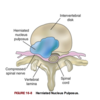Patho - Neurological System Flashcards
(568 cards)
Describe how the nervous system is divided STRUCTURALLY and its components.
1) Central Nervous System (CNS)
- brain (enclosed within cranial vault)
- spinal cord (enclosed within vertebrae)
2) Peripheral Nervous System (PNS)
- cranial nerves
- spinal nerves
- ^their respective ganglia
- Peripheraly nerve pathways differentiated into:
- afferent pathways (ascending pathways): carry sensory impulses towards CNS
- efferent pathways (descending pathways): carry motor impulses and innervate skeletal muscle/effector organs (away from CNS)
Describe how the peripheral nervous system is divided FUNCTIONALLY.
1) Somatic NS - has motor and sensory pathways that regulate voluntary motor control (i.e. skeletal muscle)
2) Autonomic NS - motor and sensory pathways involved with regulating internal environment (viscera) via involuntary control or organ systems; located in both CNS and PNS
- further divided into:
- sympathetic - responds to stress by mobilizing energy stores, prepares body for defense
- parasympathetic - conserves energy and body’s resources
- both systems function at the same time more or less

Define: effector organs
organs that are innervated by specific components of the NS
What are the two types of cells that make up nervous tissue? Describe what they are and their function in the nervous system.
Neurons: primary cell of NS; electrically excitable cell and transmits information
Non-neuronal neuroglial cells: provides structural support, protection, nutrition for neurons, facilitate neurotransmission
- in CNS: astrocytes, microglia, oligodendrocytes
- in PNS: Schwann cells (neurilemma), satellite cells (a type of Schwann cell)
Structure and Function of neurons
Structure: varies throughout the nervous system (adapted to perform specialized functions)
- three components:
- Soma: cell body (mostly located within CNS and densely packed called nuclei; in PNS, they are in dense groups called ganglia)
- Dendrites: thin branching fibers of the cell; receptive portion of neuron - carry nerve impulses toward cell body
-
Axons: long conductive projections, carry nerve impulses away from cell body
- usually one axon per neuron
Function: detect environmental changes, initiate body responses to maintain dynamic steady state

Cellular components of a neuron
composed of:
- microtubules: transport substances within cell
- neurofibrils: very thin supportive fibers extending throughout neuron
- microfilamnes: transport of cellular produces
- Nissl substances: ER and ribosomes; protein synthesis
Fuel source for neuron
predominantly glucose (without need for insulin for glucose uptake)
Definition: Axon hillock
- cone-shaped process where axon leaves the cell body (i.e. initial segment of axon)
- first part of axon hillock has lowest threshold for stimulation (action potentials begin here)
Axons are wrapped in what material, and what purpose does this serve?
myelin sheath membrane (segmented layer of lipid material called myelin)
insulating substance that speeds impulse propagation (allows action potential to leap between segments rather than flowing along entire axon length = increased velocity)
Definition: Nodes of Ranvier
- periodic gaps in the myelin sheath
- allows for nutrient exchange at these nodes (because you can’t along the myelin sheath) and for axons to branch (forming axon collaterals)
Myelin is produced by what?
In the CNS: produced by oligodendrocytes
In the PNS: produced by Schwann cells
Axons end with what structure?
Telodendria - forms the presynaptic vesicles (synaptic knobs) for neurotranmission

Divergence vs. Convergence (in the context of neurons)
Divergence: ability of branching axons to influence many different neurons
Convergences: branches of various numbers of neurons “converge” on and influence a single neuron
Define Saltatory conduction
describes the way an electrical impulse (flow of ions) skips from node to node down the full length of an axon allowing for faster conduction of an action potential rather than travelling down entire length of axon
Conduction velocity depends on what factors?
1) Myelin coating: presence of myelin = increased velocity
2) Axon diameter: larger axons transmit impulses at a faster rate
Neurons are structurally classified based on number of processes/projections extending from the cell body. What are the four types of neuron configuration/cell types?
1) Unipolar: have one process/projection that branches shortly after leaving cell body (ex. in retina)
2) Pseudounipolar: one axon process and one dendritic process but both fused to each other near cell body; dendritic portion extends away from CNS and axon portion projects into the CNS (ex. sensory neurons in cranial and spinal nerves)
3) Bipolar: have two distinct processes (one axon, one dendrite) arising from cell body (ex. connecting rods and cones in retina)
4) Multipolar: most common; multiple processes with extensive branching (ex. motor neurons)

How are neurons functionally classified?
1) Sensory: afferent, mostly pseudounipolar - carry impulses from peripheral sensory receptors to CNS
2) Associational (aka interneurons): multipolar - transmits impulses from neuron to neuron (sensory to motor neurons); solely located in the CNS
3) Motor: efferent, multipolar - transmit impulses away from CNS to an effector (skeletal muscle or organ)
In skeletal muscle, the end processes of the neuron form a ________________.
neuromuscular (myoneural) junction - basically where neuron meets muscle
In a synapse, the space between the two neurons is called:
synaptic cleft
Neuroglia (i.e. nonneuronal cells) comprise ~ _____ the total brain and spinal cord volume, and are ___ times more numerous than neurons.
half; 5-10x
Function of astrocytes
contribute to synaptic function in CNS
- surround blood vessels & fill spaces between neurons: form specialized contacts between neuronal surfaces and blood vessels
-
contribute to synaptic function in CNS
- provide rapid transport for nutrients and metabolites
- essential component of the blood-brain barrier
- scar forming cells of the CNS (involved with seizures)
- assist in processing information and memory storage

Function of oligodendroglia/oligodendocytes
form myelin sheaths within CNS

Function of ependymal cells
line the CSF-filled cavities (ventricles and choroid plexuses) of the CNS

Function of microglia
remove debris (phagocytosis) in the CNS






































































